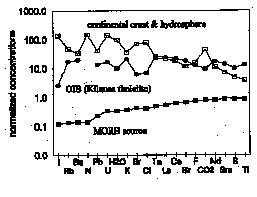
Relative to the primary mantle, MORB are variably depleted in volatiles. These depletions are balanced by comparatively high volatile concentrations in OIB and in the continental crust/hydrosphere. Peaks for H2O, CO2 and halogens in the pattern of the continental crust/hydrosphere are mirrored by troughs in the pattern for OIB. The contrasting patterns can be interpreted as the result of volatile degassing and recycling during the earth's early history. Minor but widespread partial-melting of the primary mantle depleted the mantle in volatiles and (non-volatile) incompatible elements and gave rise to the MORB source. Volatiles released from early crust-forming magmas gave rise to the hydrosphere and atmosphere. Recycling of the resultant (volatile-depleted) crust into the mantle gave rise to the OIB source with its relative volatile depletions. As with non-volatiles, the variable depletions of volatiles in MORB must reflect differences in volatile compatibilities during partial melting of mantle rocks. Current rates of volatile recycling between the continental crust/hydrosphere and mantle are relatively slow and probably approach a steady state, with current volatile concentrations in the mantle being limited by the low melting temperatures of volatile-rich mantle rocks.
Fig. 1: Volatile and non-volatile incompatible element concentrations (normalized to primary mantle concentrations) in MORB, OIB and the continental crust/hydrosphere.